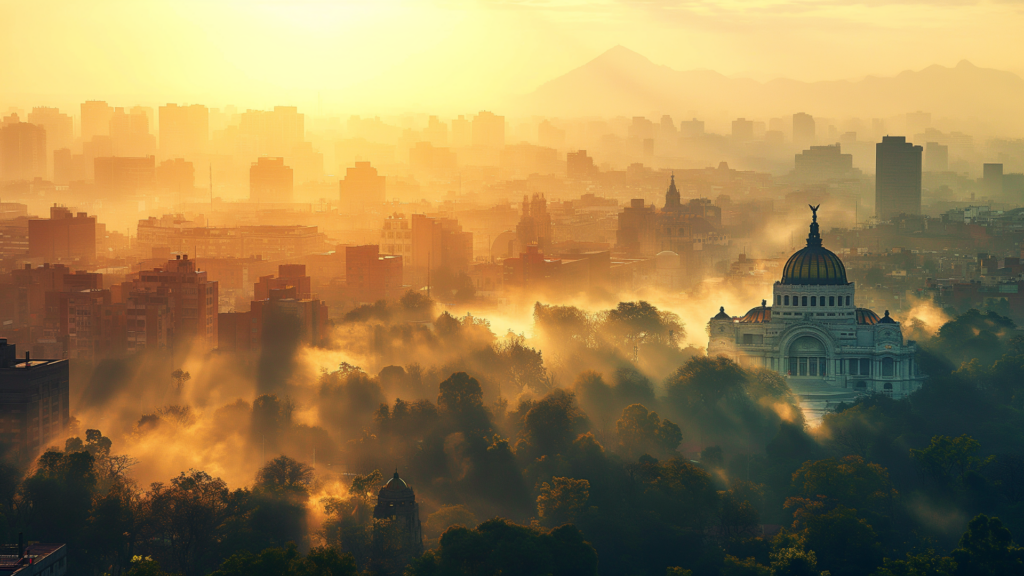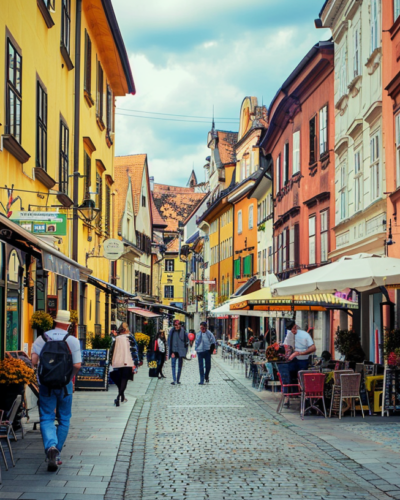Journey through the heart of Mexico City, where ancient Aztec history and foundations blend seamlessly with vibrant urban life. Discover how the enduring spirit of Tenochtitlán shapes the city’s culture, cuisine, and architecture, offering a timeless adventure in one of the world’s most dynamic metropolises.

You’re not just arriving at the largest city in Mexico when you land in Mexico City. You’re also stepping into a living museum— one that stands majestically atop the ancient ruins of Tenochtitlán. This bustling metropolis harmonizes the echoes of Aztec history and its ancestors with the rhythm of modern life. Such a combination creates a tapestry of the past and contemporary vibrancy unmatched anywhere else.
The past is certainly not buried in Mexico City. Instead, it’s interwoven with the daily lives of the city’s locals, offering a unique glimpse into the Aztec legacy that shaped not only the city but also the entire world. Whether you’re a history buff, culture enthusiast, or simply in search of a journey that tells a legendary story, traveling to Mexico City will surely make you want to explore its rich heritage, where ancient Aztec history is forever entwined with its forward-moving pulse.
Echoes of Tenochtitlán: Uncovering Aztec Ruins in Mexico City’s Heart
The story of Mexico City (or CDMX as it’s otherwise known), begins with its Aztec foundation in Tenochtitlán— an awe-inspiring city-state that once commanded the Valley of Mexico from its central island in Lake Texcoco. Founded in 1325 under the watchful guidance of a prophecy and an eagle perched on a nopal cactus, Tenochtitlán was the heart of the Aztec Empire, showcasing remarkable engineering, sophisticated agriculture, and profound spiritual significance.
Today, the spirit of Tenochtitlán lingers in the air and the soil of Mexico City. Of course, the most palpable testament to its enduring legacy is the Templo Mayor, a grand complex that was once the epicenter of Aztec religious life. Excavations done on this site have unveiled a treasure trove of artifacts and structures that narrate the Aztecs’ connection to their gods and their unyielding mastery over their environment. Walking through the remnants of the Templo Mayor, visitors are transported to a time when this place used to be the heart of an empire, resonating with the footsteps of priests and the whispers of ancient chants.
However, Tenochtitlán’s influence extends beyond its physical ruins; it also permeates the very essence of Mexico City. From the city’s layout, mimicking the cardinal directions sacred to Aztec history, to the culinary traditions that still celebrate Aztec ingredients, the ancient city’s blueprint is imprinted on the modern metropolis. Even the Zócalo, Mexico City travel’s bustling main square, sits atop what was once the ceremonial center of Tenochtitlán, linking the past and present in a vibrant dance of history and culture.
In every corner of Mexico City, the legacy of Aztec history invites exploration and discovery, offering a glimpse into a civilization that, against all odds, continues to shape the identity of this sprawling urban landscape.
Aztec Influences in Modern Mexico City: A Legacy Carved in Time
The Aztec heritage of Mexico City is not only relegated to museums and history books; it’s evidently a vibrant part of the city’s fabric, breathing life into its architecture, street names, and public spaces. The Grand Canal— an engineering marvel that rivals the ancient waterways of Tenochtitlán, still plays a crucial role in the city’s water management. It is a testament to Aztec culture ingenuity that persists in the modern era.
Additionally, the Nahuatl language, considered the native tongue of the Aztecs, echoes through the city in places named as Chapultepec (Hill of the Grasshopper) and Coyoacán (Place of the Coyotes), weaving an indigenous narrative into the urban landscape.
Moreover, Aztec traditions also continue to shape the city’s cultural and spiritual life. The most vivid example of this is Día de los Muertos— a UNESCO-recognized celebration that traces its origins back to Aztec festivities honoring the dead. During this time, Mexico City travel transforms with marigold pathways and vibrant altars, bridging ancient beliefs with contemporary expressions of love and remembrance. Such tradition underscores the Aztec view of death not as an end but as a part of life’s continuum, a philosophy deeply embedded in the city’s cultural ethos and now ours as well (largely thanks to the 2017 animated film Coco).
Walking Through History: A Mexico City Guide to Aztec Sites
For travelers keen to unravel the threads of Aztec history, Mexico City travel offers unparalleled portals into the past. The Templo Mayor serves as a cornerstone of Tenochtitlán, which invites exploration right in the city’s center. Here, amid the ruins of this vast temple complex, one can marvel at the advanced civilization that mastered the lake on which their capital stood. Artifacts unearthed from this site, displayed in the adjacent museum, tell tales of Aztec spirituality, politics, and daily life.
A journey to Teotihuacan (though not Aztec culture in origin yet still revered as a holy site by the tribe), rewards visitors with its towering Pyramids of the Sun and Moon. The Aztecs believed these pyramids were where the gods created the universe. The scale and grandeur of Teotihuacan serve as a humbling reminder of the region’s ancient complexity and the Aztec reverence for its predecessors.
Not to be overlooked, the Plaza de las Tres Culturas in Tlatelolco encapsulates the convergence of pre-Hispanic, colonial, and modern eras. It’s here that one finds the remnants of an Aztec ceremonial center side by side with colonial churches and modern architecture. Tlatelolco is also the site of the tragic 1968 student massacre, making it a poignant testament to the layers of history that really define Mexico City.
These sites, among others, offer a mosaic of insights into Aztec influence and the broader sweep of history that has shaped Mexico City. Each visit brings into sharper relief the enduring legacy of the Aztecs, inviting travelers to connect with a past that continues to echo through the streets and squares of this dynamic metropolis.
From Past to Palette: Aztec Legacy in Mexico City’s Arts and Culture
Mexico City‘s art scene also vibrantly echoes the legacy of Aztec culture as it reverberates through modern life. Blending ancient motifs into contemporary expressions that captivate both locals and visitors, even street murals across the city can narrate stories of Aztec mythology and cosmology. Local artists continue to immortalize these themes in sprawling frescoes that adorn public buildings. Such modern canvases, rich with symbolism, serve as a bridge connecting the city’s past with its present.
The National Museum of Anthropology stands as a guardian of this rich heritage, housing the world’s largest collection of Aztec history artifacts. Among its treasures, the Stone of the Sun (often mistakenly called the Aztec calendar), offers insight into the Aztecs’ understanding of time and the cosmos. This museum, along with the Templo Mayor Museum, provides a comprehensive exploration of Aztec life for those wanting to immerse in the culture. From their daily routines to their complex spiritual beliefs, visitors are invited to delve into a world where art and culture are intrinsically linked to Mexico City travel’s ancient roots.
Culinary Traditions: Savoring the Flavors of the Aztec Empire in Mexico City
The flavors you get to taste from any Mexico City travels are a true testament to the enduring influence of Aztec culinary traditions. This only goes to show that ancient ingredients and techniques remain central to Mexico City’s fascinating gastronomy. Corn, beans, chilies, and nopal (cactus) form the backbone of dishes that have been savored in this region for centuries. Nixtamalization, a process developed by the Aztecs for treating maize, remains essential for creating masa, the dough that becomes tortillas, tamales, and other staples of Mexican cuisine.
For a taste of Aztec heritage, visitors can also explore markets like La Merced or eateries offering pre-Hispanic cuisine, such as escamoles (ant larvae) and huitlacoche (corn fungus), delicacies once prized by Aztec nobility.
Weary travelers need not worry as they can stay in La Roma House, just a walking distance away from the city’s more famous restaurants. And you can bet that even the contemporary chefs hailing from premier Mexican hotels are also embracing these ingredients, infusing traditional dishes with modern flair and presenting a culinary journey through time.
This fusion of past and present not only honors Aztec gastronomic legacy but also showcases the innovative spirit of Mexico City’s culinary scene, inviting food enthusiasts to explore a rich palette of flavors deeply rooted in the city’s history.
The Spirit of Tenochtitlán: Living Aztec Culture in Modern Mexico City
In the heart of Mexico City, the spirit of Tenochtitlán thrives, not just in its tangible history but in the ethos of its people. The Aztecs’ values of resilience, ingenuity, and environmental harmony are mirrored in the city’s modern advancements and sustainable practices.
Urban gardens on rooftop terraces echo the ancient chinampas, floating gardens that fed a civilization. Events like the reenactment of the mystical Aztec culture dance, La Danza de los Voladores, remind us of a culture deeply connected to the earth and the cosmos. This living heritage is embraced and celebrated, weaving Aztec traditions into the fabric of daily life.
For travelers wanting to immerse themselves in this vibrant culture, accommodations such as The New Carso Alameda Luxury Lofts, situated close to the historic center, and Grand Chapultepec Residencial, a mere stone’s throw from the Templo Mayor, offering panoramic views of the Aztec city’s former expanse, serve as gateways to exploring the ancient and modern worlds colliding in this metropolis.
Embracing the Aztec Past for a Richer Mexico City Travel Experience
Mexico City‘s journey from the Aztec history empire of Tenochtitlán to a bustling modern capital is a testament to the enduring legacy of its original inhabitants. The city’s architecture, culinary scene, arts, and festivals pay homage to an ancient civilization whose influence permeates every street corner and square.
This City Knows invites you to delve beyond the surface, to see, taste, and experience the living Aztec heritage that makes Mexico City travel a truly unique destination. Engaging with this rich history offers a more profound and enriching travel experience, connecting travelers to the heart and soul of one of the world’s most fascinating cities.









